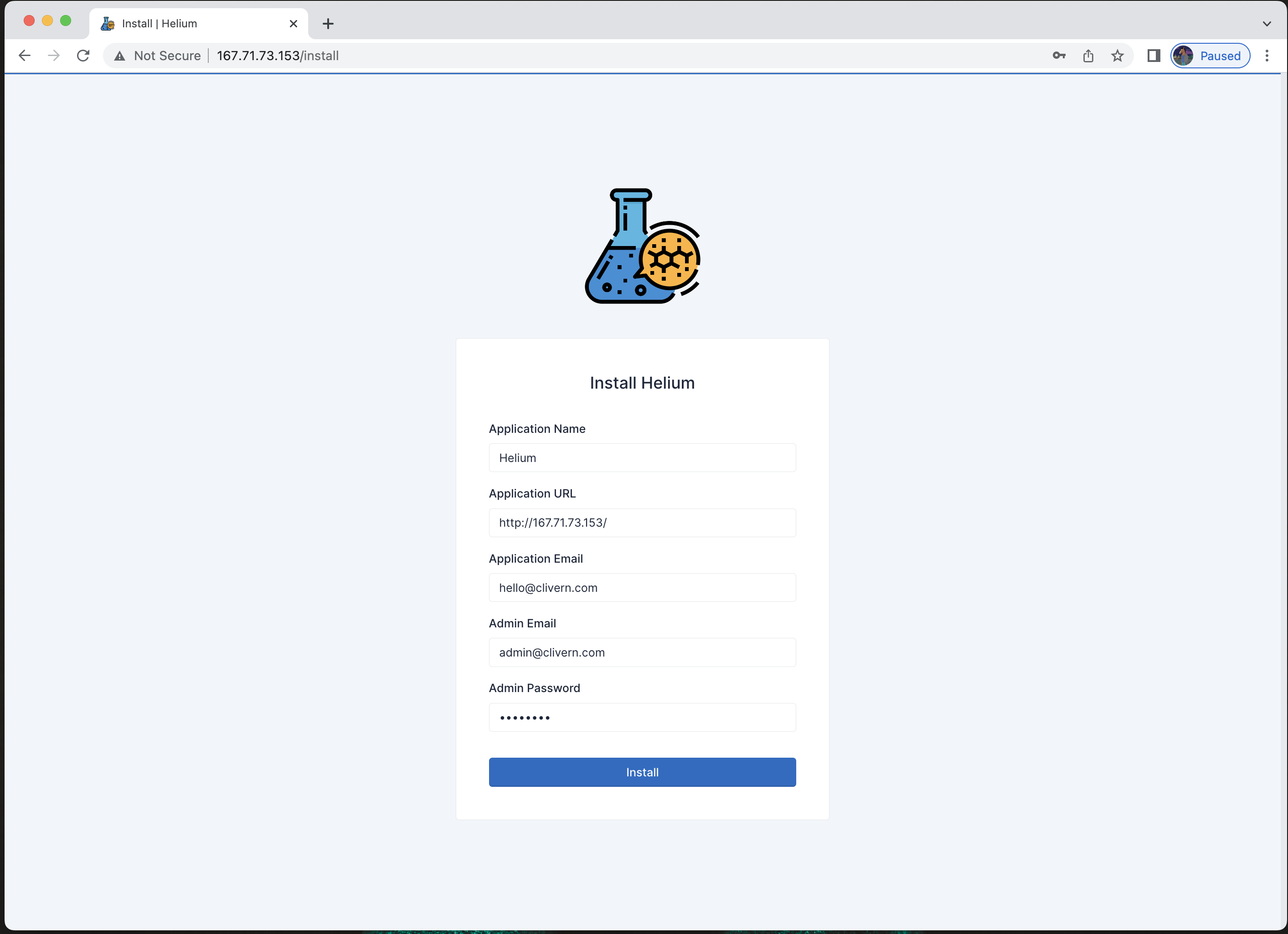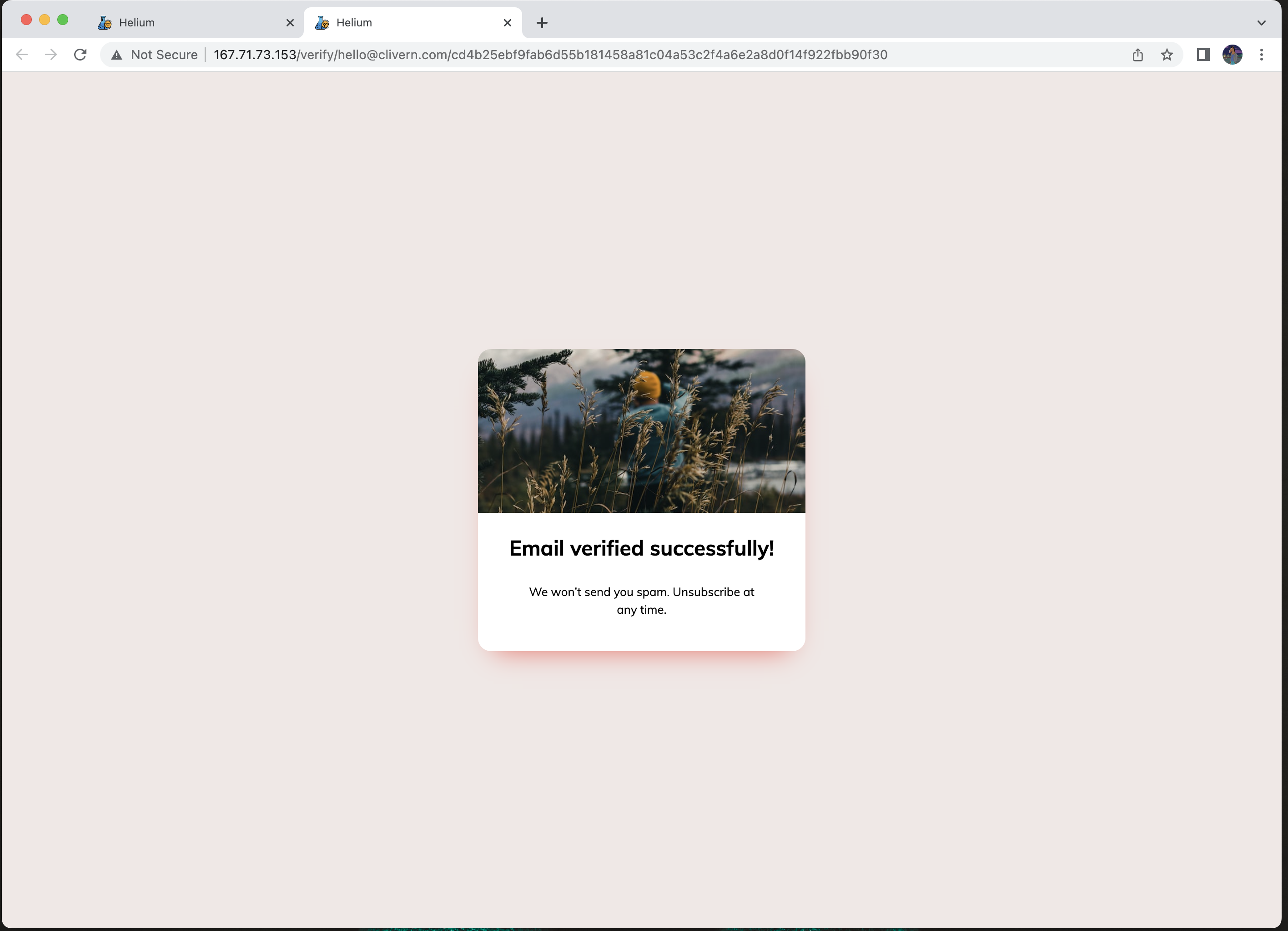
Helium
Helium is a Fast, Secure and Reliable Newsletter System. Helium is perfect for weekly articles newsletter, featured articles newsletter, marketing campaigns or even product updates. It integrates easily with most of SMTP providers out there. It is built with Symfony 5.4 LTS to support a broad range of PHP versions plus symfony extended support.
Some Features
- Easy Setup.
- Statistics dashboard with trends in subscribers and newsletters.
- Fast email delivery. you can run any number of workers for massive numbers of subscribers and newsletters.
- Scheduled newsletters support.
- Customizable newsletter page.
- Customizable newsletter emails.
- Powerful templating engine for newsletter emails.
- Powerful templating engine for newsletter page.
- Search engine optimized.
- Integrates easily with any SMTP services like
Postfix,Gmail,SendGrid,Sendinblue,Postmark,Mailgun,Mailchimp,Amazon SES,Mailtrap. - Automated deployment and upgrades with Ansible.
- Translation Ready.
- Fully Ajax.
- Developer Friendly.
- Well documented code.
- Amazing Support.
Free Hosting
You can get at least 3 months of a free hosting to run Helium. Please feel free to use one of the following links to register:
- $200 from Digitalocean.
- $250 from Vultr.
- $300 from Google Cloud.
- 12 Month free from AWS.
- $100 from Linode.
Requirements
- Linux Operating System.
- Apache or Nginx with PHP-FPM
- PHP 7.4+.
- MySQL 5+ or MariaDB.
- Composer.
We suggest using a Virtual Server (VPS) not shared hosting since Helium requires a two running background process to send emails on time. You can get a free VPS for at least three months, Please check free hosting section
Manual Installation
-
Please follow this guide to install ubuntu 22.02 with Nginx, MySQL, PHP-FPM
-
if you deployed helium to this path
/var/www/project/you need to create two systemd services. -
To install PHP packages optimized for production.
$ make prod_composer
- To migrate the database, you can use the following command
$ make migrate
- The
watchersystemd service.
$ nano /etc/systemd/system/watcher.service
[Unit]
Description=Helium Watcher
After=network.target
StartLimitIntervalSec=500
StartLimitBurst=5
[Service]
User=root
Group=www-data
WorkingDirectory=/var/www/project
Restart=on-failure
RestartSec=5s
Environment=LANG=en_US.UTF-8
Environment=LC_ALL=en_US.UTF-8
Environment=LC_LANG=en_US.UTF-8
ExecStart=php /var/www/project/bin/console watch
ExecReload=/bin/kill -s HUP $MAINPID
ExecStop=/bin/kill -s TERM $MAINPID
PrivateTmp=true
[Install]
WantedBy=multi-user.target
- The
workersystemd service.
$ nano /etc/systemd/system/worker.service
[Unit]
Description=Helium Worker %i
After=network.target
StartLimitIntervalSec=500
StartLimitBurst=5
[Service]
User=root
Group=www-data
WorkingDirectory=/var/www/project
Restart=on-failure
RestartSec=5s
Environment=LANG=en_US.UTF-8
Environment=LC_ALL=en_US.UTF-8
Environment=LC_LANG=en_US.UTF-8
ExecStart=php /var/www/project/bin/console messenger:consume async
ExecReload=/bin/kill -s HUP $MAINPID
ExecStop=/bin/kill -s TERM $MAINPID
PrivateTmp=true
[Install]
WantedBy=multi-user.target
- Then enable and start them
$ systemctl enable watcher
$ systemctl start watcher
$ systemctl enable worker@1
$ systemctl start worker@1
Installation with Ansible (preferred)
You need to install Python 3 locally and use a laptop that has SSH access to the production Linux server. Then please follow these steps:
- Create a python virtual environment.
$ python3 -m venv venv
$ source venv/bin/activate
- Install
ansible
$ make config
-
Create
hosts.prodfromhostsfile and replace127.0.0.1with the host IP. -
Create
prod.vault.ymlwith these configs.
$ ansible-vault create prod.vault.yml
install_mysql: true
root_username: root
root_password: R2ZBmTR6nED6a71AxeTO2DSck
app_db_name: helium
app_db_username: admin
app_db_password: R2ZBmTR6nED6a71AxeTO2UIok
allow_access_from: "127.0.0.1"
install_nginx: true
install_php: true
php_version: 8.1 # or 7.4 on Ubuntu 20.04
install_composer: true
install_postfix: false
postfix_hostname: helium
smtp_sasl_security_options: noanonymous
smtp_sasl_auth_enable: 'yes'
smtp_use_tls: 'yes'
smtp_server: smtp.gmail.com
smtp_port: 587
smtp_username: ''
smtp_password: ''
inet_interfaces: 127.0.0.1
Postfix is disabled but it can be enabled by setting install_postfix: true above and providing the SMTP Server, username and password. You can use your gmail account as an SMTP server by doing the following:
- The
SMTP serverwill besmtp.gmail.comand port587 - The
SMTP usernameis your gmail email address. - The
SMTP passwordcan be generated after enabling two factor authentication. Please check this guide to generate the app password https://www.golinuxcloud.com/gmail-smtp-relay-server-postfix/.
- Run ansible playbook to setup the server
$ make prod
Here is an article explaining the above steps in more details
To Deploy Helium Application:
The following steps will require you to upload the code to a private github or gitlab repository, Add the host public key as a deploy key Then provide the repository git link.
- Create
helium.vault.ymlwith these configs.
$ ansible-vault create helium.vault.yml
app_user: appmgmt
app_group: appmgmt
app_version: 1.0.0
git_repo: git@github.com:$AUTHOR/$REPO.git
workers_counts: 1
hostname: helium.com
php_version: 8.1 # or 7.4 on Ubuntu 20.04
app_db_name: helium
app_db_username: admin
app_db_password: R2ZBmTR6nED6a71AxeTO2UIok
app_secret: 3999bf7e3a408f15942779447e01dd7a
app_timezone: UTC
app_env: prod
app_locale: en
messenger_transport: doctrine://default
mailer_dsn: sendmail://default
Please not that mailer_dsn can be one of the following forms:
# If Amazon Mailer
mailer_dsn: ses://ACCESS_KEY:SECRET_KEY@default?region=eu-west-1
mailer_dsn: ses+smtp://ACCESS_KEY:SECRET_KEY@default?region=eu-west-1
# If Mailchimp
mailer_dsn: mandrill://KEY@default
mailer_dsn: mandrill+smtp://USERNAME:PASSWORD@default
# If mailgun
mailer_dsn: mailgun://KEY:DOMAIN@default?region=us
mailer_dsn: mailgun+smtp://USERNAME:PASSWORD@default?region=us
# If Mailjet
mailer_dsn: mailjet+api://PUBLIC_KEY:PRIVATE_KEY@api.mailjet.com
mailer_dsn: mailjet+smtp://PUBLIC_KEY:PRIVATE_KEY@in-v3.mailjet.com
# If Postmark
mailer_dsn: postmark://ID@default
# If Sendgrid
mailer_dsn: sendgrid://KEY@default
# If Sendinblue
mailer_dsn: sendinblue+api://KEY@default
mailer_dsn: sendinblue+smtp://USERNAME:PASSWORD@default
# If Mailtrap
mailer_dsn: smtp://USERNAME:PASSWORD@smtp.mailtrap.io:2525?encryption=tls&auth_mode=login
- Run ansible playbook to deploy
Heliumapplication.
$ make helium
Configuration
Once you have installed Helium on a server. Please follow the following steps setup the application and also send your first newsletter:
- Visit
HeliumURL and it will redirect to/installpage. You will need to provide the application and admin data.


- Then you can login with the
Admin EmailandAdmin Password.


- It is optional to update your profile. Inserting your first and last name.

- It is optional to update the settings.

- Then we need to add our first subscriber. Please use your personal email. You can either subscribe from the homepage like other users or insert the email manually from the dashhboard.





-
Now we can send our first newsletter:
- Open Newsletters then click
Add Newbutton. - Provide the newsletter name for example
PHP Weekly Newsletter - Select delivery to be now or anytime in the future.
- Select Template, the default values will show on template Inputs, you must change these values to your linking.
- A button preview will show up once you update either the template or inputs to view the newsletter.
- For more info how these template works, please check the advanced section.
- Once you click submit with a delivery now, Helium will start sending emails immediately.
- Open Newsletters then click


Advanced
- Which template engine helium is using?
Helium uses the symfony default templating engine Twig. Here is a guide how to use twig
- How to build a new home page template?
By default helium scans the templates/default/page/home.$layout.html.twig. To create a new layout called creative. create a new file templates/default/page/home.creative.html.twig from templates/default/page/home.default.html.twig. then customize the look and feel.
You can activate the new layout from the dashboard > settings page, select the creative layout.
- How to build a new newsletter email template?
Let's create a new newsletter template for product updates. First we create templates/default/newsletter/product_updates.distro.html.twig and templates/default/newsletter/product_updates.distro.yml.
By default the following variables are available to be used in your newsletter template
app_nameapp_urldata.unsubscribe_url
You can define some dynamic data in templates/default/newsletter/product_updates.distro.yml
logo_url: 'https://via.placeholder.com/360x170'
updates:
-
title: How to Setup a HA Cassandra Cluster
img_url: 'https://via.placeholder.com/1200x700'
link: 'https://clivern.com/how-to-setup-a-ha-cassandra-cluster/'
description: >-
Apache Cassandra is a NoSQL database with flexible deployment options that’s
highly performant (especially for writes), scalable, fault-tolerant, and
proven in production. Alternative NoSQL databases include Amazon DynamoDB,
Apache HBase, and MongoDB.
-
title: How to Setup a HA Cassandra Cluster
img_url: 'https://via.placeholder.com/1200x700'
link: 'https://clivern.com/how-to-setup-a-ha-cassandra-cluster/'
description: >-
Apache Cassandra is a NoSQL database with flexible deployment options that’s
highly performant (especially for writes), scalable, fault-tolerant, and
proven in production. Alternative NoSQL databases include Amazon DynamoDB,
Apache HBase, and MongoDB.
-
title: How to Setup a HA Cassandra Cluster
img_url: 'https://via.placeholder.com/1200x700'
link: 'https://clivern.com/how-to-setup-a-ha-cassandra-cluster/'
description: >-
Apache Cassandra is a NoSQL database with flexible deployment options that’s
highly performant (especially for writes), scalable, fault-tolerant, and
proven in production. Alternative NoSQL databases include Amazon DynamoDB,
Apache HBase, and MongoDB.
You can access the above data from the template using data.logo_url and data.updates like the following
{% for update in data.updates %}
<img src="{{ update.img_url }}">
<table>
<tbody>
<tr>
<td >
<h1>{{ update.title }}</h1>
<p>{{ update.description }}</p>
<a href="{{ update.link }}">
<span>Learn more</span>
</a>
</td>
</tr>
</tbody>
</table>
{% endfor %}
Please note that all variables in the product_updates.distro.yml can be accessed by data.$$
Translation
Please translate the messages.xlf included with the release files and send the translated file to hello@clivern.com.
<?xml version="1.0" encoding="utf-8"?>
<xliff xmlns="urn:oasis:names:tc:xliff:document:1.2" version="1.2">
<file source-language="en" target-language="fr" datatype="plaintext" original="file.ext">
<header>
<tool tool-id="symfony" tool-name="Symfony"/>
</header>
<body>
<trans-unit id="TnDx.SS" resname="Reset Password">
<source>Reset Password</source>
<target>réinitialiser le mot de passe</target>
</trans-unit>
Support
Please read help files included with my items before anything.
Support for my items includes:
- Answering technical questions about item’s features.
- Assistance with reported bugs and issues.
- Providing updates to ensure compatibility with new software versions.
- Help with included 3rd party assets.
Support for my items do not include:
- Customization and installation services.
Please send any support request to this email hello@clivern.com. We’re glad to help!
Security
If you discover a security vulnerability within Helium, please send an email to hello@clivern.com
Versioning
For transparency into our release cycle and in striving to maintain backward compatibility, Helium is maintained under the Semantic Versioning guidelines and release process is predictable and business-friendly.
See the changelog section for changelogs for each release version of Helium. It contains summaries of the most noteworthy changes made in each release.
Credits
- Symfony - PHP Framework.
- Tabler - HTML Dashboard UI Kit built on Bootstrap.
- Vuejs.
- jQuery.
- Axios.
- Toastr.
- Ansible.
- mdBook.
Changelog
Version 1.0.0:
- Initial Release.
License
© 2022, Clivern. Released under MIT License.
Helium is authored and maintained by @clivern.